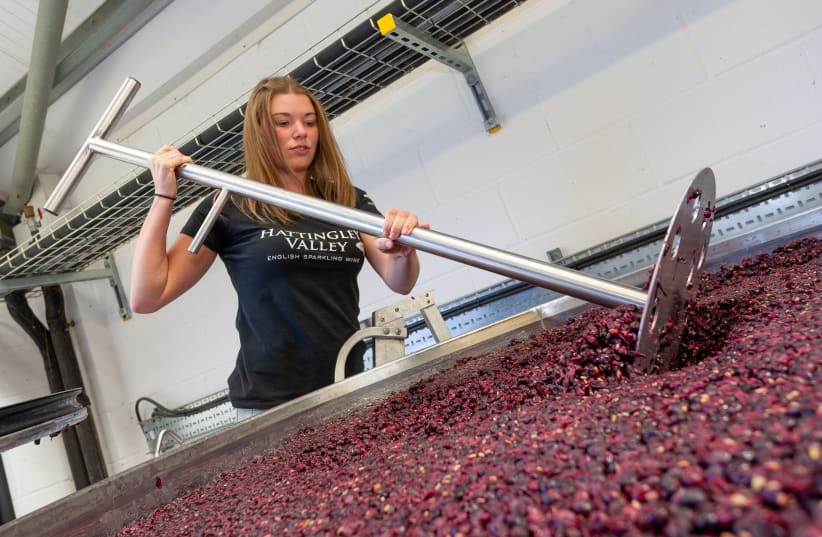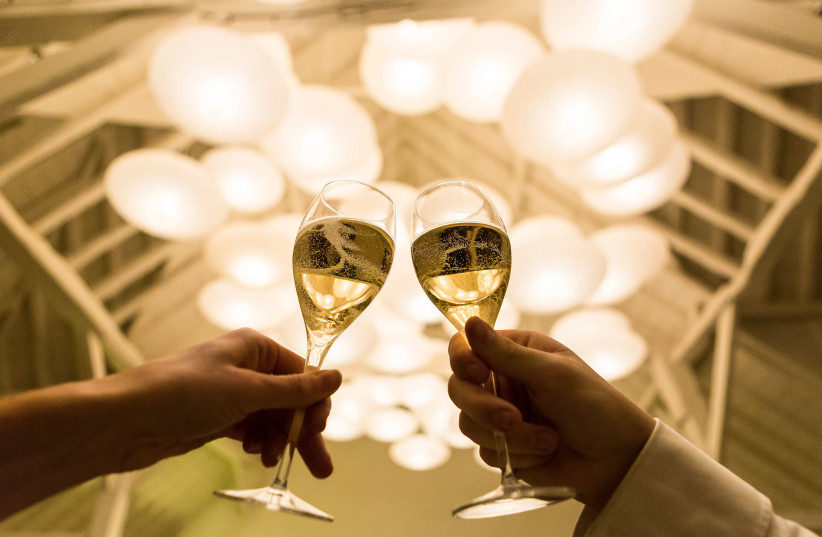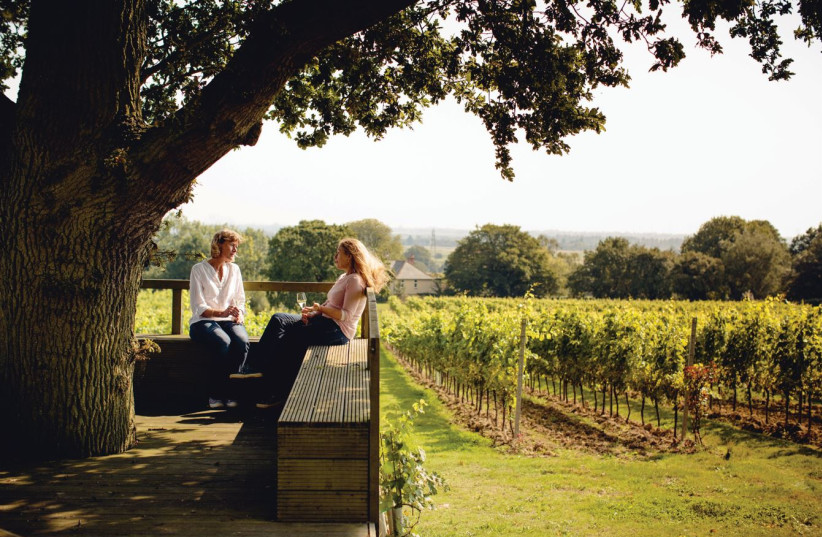I was born in London, brought up in England and now live in Israel. I have spent exactly 32 years of my life in the UK and 32 years in Israel, and can now sing the Beatles song “When I’m Sixty-Four” with real meaning. It is a complete coincidence that both my country of birth and my adopted country form the northern and southern extremities of quality winemaking in the northern hemisphere.
Believe it or not, good wine is being made in Yorkshire in the North of England and the Negev Desert is becoming a wine growing region of great interest. Between the latitudes of Yorkshire and the Negev, lie all the great and historic wine regions of Europe. Suddenly, while our backs were turned, English wine became an item.
It is said that wine in the Sceptered Isle began with the Romans. Whether they actually made wine in Britain or just bought copious amounts to drink, is open to question. However England has always been a place where new stories, wine styles and brands were tried, tested and developed, before conquering the rest of the world. New trends have always tended to start there. In any case, the UK punches above its weight. It is the fifth largest wine market in the world for wine consumption.
The first modern vineyard was planted at Hambledon in Hampshire in the early 1950s. This is the very same village that was the home and cradle of cricket! This is a wonderful game beloved by the Brits, but regarded as an odd, impossible to understand, English eccentricity by Israelis.
By the time I began to notice English wine, it was made by wealthy or idealistic hobbyists, or gentlemen farmers. Growing grapes was a painful, expensive process in the marginal English climate, and the wines were usually from whites made from simple German crosses or hybrid varieties. Some were nice enough, but there was no calling card of memorable quality or consistency.
In the mid-1980s, I was wine manager of Bass Charrington’s hotel division. In a leap of faith, I boldly put an Israeli and English wine on the corporate wine lists. No one can say I was not patriotic. For the record, the English wines were Three Choirs and Carr Taylor, and the Israeli wines were Yarden and Gamla. English sparkling wine was not considered that special in those days, though Carr Taylor was determinedly pursuing the idea of sparkling wine at the time.
The revolution started with a winery called Nyetimber Vineyard, out of nowhere. With great boldness, determination and total belief in its own truth, the Moss family from Chicago planted Chardonnay, Pinot Noir and Pinot Meunier, the “holy trinity” of grapes from the Champagne region, on the chalky soil of East Sussex. It was an off-the-wall decision. The first planting was in 1988, the first wine was made in 1992, but it was not launched until 1997, when it won the Best English Wine Trophy. Such is the timeline for quality sparkling wine. Those without finance, perfectionism and a mad obsession to fulfill their vision would simply not have had the patience to stand the course.
There was no history that guaranteed success, but they were extremely determined people. In 1998 they won the Sparkling Wine Trophy at the International Wine & Spirit Competition (IWSC) in London. The wine was the Nyetimber Classic Cuvee 1993. Forgotten by everyone except me, the full name of the award was The Yarden Trophy for Best Bottle Fermented Sparkling Wine. The reason for the Israeli connection was that Yarden Blanc de Blancs had won the same trophy in 1996, and after this success, I arranged the sponsorship deal as I then worked for the Golan Heights Winery! Small world!
Now, in those days, the IWSC was outstandingly the most important international competition. In 1987, the Yarden Cabernet Sauvignon 1984 had sensationally won the Winiarski Trophy and Gold Medal. It was the beginning of the quality revolution in Israeli wine.
A decade later, Nyetimber’s success had a similar effect in Great Britain, and English and Welsh wine pirouetted at that moment from an undistinguished past, and reinvented itself as a producer of high-quality, traditional-method sparkling wines. Nyetimber was the pioneer and the catalyst, exactly like the Golan Heights Winery, but has since been joined by a host of very serious producers. The success of the pioneers, global warming, the influx of new expertise and a very good summer in 2003, all contrived to change thinking and attract investors.
Nyetimber kept on winning competitions. Then, in the 2010 Decanter World Wine Awards, another winery founded in the 1990s reached the heights. Ridgeview Estate’s Grosvenor Blanc de Blancs 2006 beat all comers to win the International Trophy for Sparkling Wines, including Champagnes on the way. This was not considered by the Decanter magazine to be the “sensation of the competition.” That was reserved for Carmel Winery’s Kayoumi Shiraz 2006 also winning the International Trophy, but the Ridgeview award received the biggest cheer! I was there, received the award on behalf of Carmel, and shared the drama and excitement of these two astonishing results. England had reinvented itself as a sparkling wine producer of some merit and no little quality.
The industry is still tiny. The heartbeat of English wine is in Kent and Sussex in the South East of England, but it extends into Hampshire. Kent is called the “Garden of England.” It was primarily known in the past for its hop farms, producing that important ingredient for British ale. It is also known for the White Cliffs of Dover. It is this chalk that is the key to the new excellence of English wine, or more specifically, English sparkling wine, because it imitates the characteristic of the Champagne terroir. Sussex is home of the South Downs, a broad range of chalky hills. However wineries have popped up all over.
Production has usually been 4 to 5 million bottles a year. In some years, like 2012, wine could barely be made, but in bumper years, like 2018, no fewer than 15 million bottles were produced. There are now 800 vineyards in Great Britain, and 178 wineries. They have 3,800 hectares under vine. In Israel we have 5,500 hectares (55,000 dunams). At present 60-70% of English wine is classic method sparkling. This is made in exactly the same way it is made in Champagne, with the second fermentation in the bottle that is sold. It is the most costly way of making sparkling wine, but undeniably produces the sparkling wines of the finest quality. The viticulturists and winemakers today are far more qualified than was previously the case, and a number of new investors have entered the game with money to burn and with the desire to ape and even beat Champagne at its own game.
England is becoming known as a one-trick pony (as New Zealand was at the beginning, with Sauvignon Blanc.) However, this will change. It is a very long, costly process making sparkling wine this way. Hence the shelf prices are not inexpensive. With the need for cash flow, the fact that it is always easier to make wine than sell it and continuing global warming, no doubt English still wines will advance in the next decade, even if they remain in the shadow of the fizz.
The main variety is called Bacchus (for the record, a Silvaner x Riesling cross, which was then wedded to Müller-Thurgau). It is a cross developed in Germany, which has caught on in the English and Welsh vineyards. It has some potential and uniqueness and provides charming fresh whites, with floral, citrusy aromas. Seyval Blanc is another white variety you will come across.
The folklore says that the blind monk Dom Pérignon discovered bubbly. A more factual, less romantic notion, is that it was an Englishman, Christopher Merret, who first recorded the idea of sparkling in 1652... and this was a few years before the Pérignon story. The Brits always like to get one over the French, especially with regard to wine, but you can believe whom you like. The Champagne houses Taittinger and Vranken Pommery have recently invested in English sparkling wine. A vote of confidence in the future.
There is no set catchy brand name like Cava or Prosecco for the Brits to market their sparkling wine. “English Traditional Method Sparkling Wine” is quite a long description to convey a very simple message. Different wineries have proposed their own solutions like British Fizz, Albion, Merret (after the aforementioned Christopher) or Britagne (a play on words), but they have not caught on. Instead the admirable Wine GB, the marketing body from which Israeli wine could learn a thing or two, calls it “Great British Classic Method.”
Time has a way of sorting these things out, but here lies a great confusion. English and Welsh wine is made from freshly gathered grapes. British wine is made from grape concentrate that can come from anywhere, and it produces sickly sweet wine that may have once been liked by your great auntie. Yet when talking about Wines of Great Britain, they are referring to real wine, made in England and Wales.
One point we can envy is that 50% of the sales of English wines are made from cellar door and Internet sales. There is quite a fast-developing tourism scene. A few names to go by: Chapel Down (Kent), Nyetimber Vineyard (West Sussex) and Ridgeview Estate (East Sussex), Hattingley Valley (Hampshire) and Camel Valley Vineyard (Cornwall) are the internationally known brands. I have affection for Breaky Bottom, Carr Taylor and Three Choirs, which were around back in the eighties, when I was in England.
Other personal favorites of mine are Black Chalk, Busi Jacobsohn, Gusbourne, Rathfinny, Roebuck, Simpsons, Wiston-Goring and, best of all, may be Sugrue South Downs, made by Dermot Sugrue, arguably the most charismatic winemaker. Did you hear the one about an Irishman from Limerick who got into wine because of his local bishop? But that is another story.
I attended the first formal tasting of English sparkling wine in Israel. I will report back. We remember when English food was a joke and English wine was virtually non-existent. Well, now, London is one of the gastronomic capitals of the world and English sparkling wine is of a quality that has to be reckoned with. The climate in southern England today is similar to Champagne just 20 years ago.
Think about that. Remember Bob Dylan: “The slow one now will later be fast... for the times they are a-changin’.”
The writer is a wine industry insider turned wine writer, who has advanced Israeli wines for 35 years. He is referred to as the English voice of Israeli wine. www.adammontefiore.com



